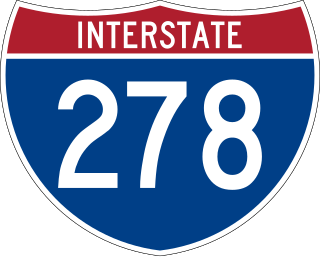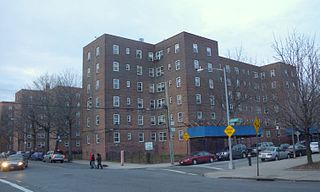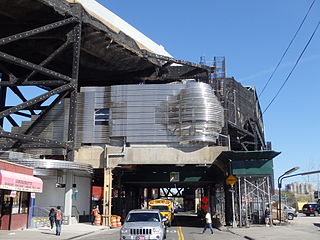
Interstate 278 (I-278) is an auxiliary Interstate Highway in New Jersey and New York in the United States. The road runs 35.62 miles (57.32 km) from US Route 1/9 (US 1/9) in Linden, New Jersey, northeast to the Bruckner Interchange in the New York City borough of the Bronx. The majority of I-278 is in New York City, where it serves as a partial beltway and passes through all five of the city's boroughs. I-278 follows several freeways, including the Union Freeway in Union County, New Jersey; the Staten Island Expressway (SIE) across Staten Island; the Gowanus Expressway in southern Brooklyn; the Brooklyn–Queens Expressway (BQE) across northern Brooklyn and Queens; a small part of the Grand Central Parkway in Queens; and a part of the Bruckner Expressway in the Bronx. I-278 also crosses multiple bridges, including the Goethals, Verrazzano-Narrows, Kosciuszko, and Robert F. Kennedy bridges.

The Gowanus Canal is a 1.8-mile-long (2.9 km) canal in the New York City borough of Brooklyn, on the westernmost portion of Long Island. Once a vital cargo transportation hub, the canal has seen decreasing use since the mid-20th century, parallel with the decline of domestic waterborne shipping. It continues to be used for occasional movement of goods and daily navigation of small boats, tugs and barges.

Red Hook is a neighborhood in western Brooklyn, New York City, New York, within the area once known as South Brooklyn. It is located on a peninsula projecting into the Upper New York Bay and is bounded by the Gowanus Expressway and the Carroll Gardens neighborhood on the northeast, Gowanus Canal on the east, and the Upper New York Bay on the west and south. A prosperous shipping and port area in the early 20th century, the area declined in the latter part of the century. Today it is home to the Red Hook Houses, the largest housing project in Brooklyn.

Boerum Hill is a small neighborhood in the northwestern portion of the New York City borough of Brooklyn, bounded by Schermerhorn Street to the north and Fourth Avenue to the east. The western border is variously given as either Smith or Court Streets, and Warren or Wyckoff Streets as the southern edge.
Brooklyn Community Board 6 is a New York City community board that encompasses the Brooklyn neighborhoods of Red Hook, Carroll Gardens, Park Slope, Gowanus, Cobble Hill and Columbia Street Waterfront District. It is delimited by Upper New York Bay and East River on the west, Atlantic Avenue, Court Street, Fourth Avenue, Warren and Pacific Streets on the north, Prospect Park on the east, as well as by the 15th Street, Hamilton Avenue and the Gowanus Canal on the south. It approximates the 19th century district of South Brooklyn.

Community boards of Brooklyn are New York City community boards in the borough of Brooklyn, which are the appointed advisory groups of the community districts that advise on land use and zoning, participate in the city budget process, and address service delivery in their district.

The Smith–Ninth Streets station is a local station on the IND Culver Line of the New York City Subway. It is located over the Gowanus Canal near the intersection of Smith and Ninth Streets in Gowanus, Brooklyn, and is served by the F and G trains at all times. The station is 87.5 feet (26.7 m) above ground level and was formerly the highest rapid transit station in the world.

The Port of New York and New Jersey is the port district of the New York-Newark metropolitan area, encompassing the region within approximately a 25-mile (40 km) radius of the Statue of Liberty National Monument.

The Canal Street station is a New York City Subway station complex. It is located in the neighborhoods of Chinatown and SoHo in Manhattan and is shared by the BMT Broadway Line, the IRT Lexington Avenue Line, and the BMT Nassau Street Line. It is served by the 6, J, N, and Q trains at all times; the R train at all times except late nights; the W train during weekdays; the <6> train during weekdays in the peak direction; the Z train during rush hours in the peak direction; and the 4 train during late nights.

Greenwood Heights is a neighborhood in the New York City borough of Brooklyn, named partially after the adjacent Green-Wood Cemetery. Greenwood Heights is a part of Brooklyn Community District 7 along with Windsor Terrace, Sunset Park and South Slope. The much-debated borders are roughly the Prospect Expressway to the north, Gowanus Canal and Upper New York Bay to the west, Eighth Avenue to the east, and 39th Street to the south.

Transportation in New York City has ranged from strong Dutch authority in the 17th century, expansionism during the industrial era in the 19th century and half of the 20th century, to cronyism during the Robert Moses era. The shape of New York City's transportation system changed as the city did, and the result is an expansive modern-day system of industrial-era infrastructure. New York City, being the most populous city in the United States, has a transportation system which includes one of the largest subway systems in the world; the world's first mechanically ventilated vehicular tunnel; and an aerial tramway.

The Brooklyn–Queens Connector, abbreviated the BQX, is a proposed streetcar line in New York City. It is planned to operate on a north–south corridor along the East River between the boroughs of Queens and Brooklyn.

The Central Power Station of the Brooklyn Rapid Transit Company building, commonly known as the Batcave or Gowanus Batcave, is a former transit power station at 153 Second Street in Gowanus, Brooklyn, New York City by the Gowanus Canal. It was built between 1901 and 1904, while the Brooklyn Rapid Transit Company was expanding its rapid transit and streetcar service. It stopped operating in 1972 and sat abandoned for more than two decades, becoming home to a community of squatters in the early 2000s. The owners, who were planning to redevelop the site, building condominiums called "Gowanus Village", had the squatters removed and increased security in 2006. The Gowanus Village plans did not materialize and after a short time it became a popular space for graffiti and underground events.

The Carroll Street Bridge is a retractable bridge in New York City, crossing the Gowanus Canal in Brooklyn. It carries a single wooden-decked lane for one-way eastbound vehicular traffic and two walkways. Completed in 1889, it is operated by the New York City Department of Transportation, with an average of about one thousand crossings each weekday. It is the oldest of the four remaining retractable bridges in the United States and is an official city landmark.

C. & R. Poillon was a 19th-century shipyard company in Brooklyn, New York. The company employed over 300 workers, owned several shipyards, and launched 175 vessels. The company was one of the best known clipper ship firms and the last of the wooden hulled boat builders in New York.

The Coignet Stone Company Building is a historical structure in the Gowanus neighborhood of Brooklyn in New York City, at the intersection of Third Street and Third Avenue. Designed by architects William Field and Son and constructed between 1872 and 1873, it is the city's oldest remaining concrete building. The Coignet Building is the last remaining structure of a five-acre concrete factory complex built for the Coignet Agglomerate Company along the Gowanus Canal.



















